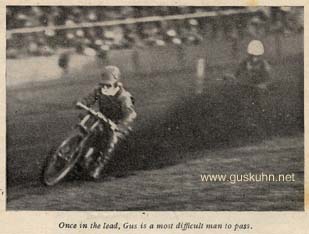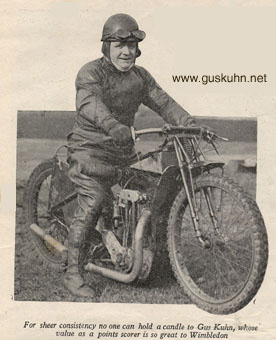|
For sheer consistency no one can hold a candle to Gus Kuhn, whose value as a points scorer is so great to Wimbledon. With its great tax on energy and fitness, it would seem as if speedway racing, above all things, would demand the comparative youth of its exponents.
As a rule this is the case, but Gus E Kuhn, born October 17th 1898, and still going strong, has confounded all the laws of convention, which say "A speedway rider is finished at 30." At the age of 38, Gus is the oldest rider, both in years and experience, on the speedway, and is riding better than ever. A wily master of track-craft, a brilliant mechanic, a darned hard man to get past (and not only because of his portly figure), and above all a thorough sportsman and a jolly good fellow. Five minutes' talk with Gus would convince you of this. There are not many things you can tell Gus about motor-cycles. They have been his chief concern ever since he had his first machine at the age of fourteen, and he prides himself on the fact that he has never had any serious mechanical trouble of any description. He won his first gold medal at fifteen. Gus had been in the speedway game since the first meeting ever held in this country. That was at High Beech in 1928. Previously he had taken part in the TT and road races all over England, and had met with considerable success. And he had seen considerable war service, too, serving with the RNVR [sic] and the RAF. That historic first meeting at High Beech has been written about time and time again, and everyone is agreed that the high spot of the afternoon was the wildly spectacular riding of Alf Medcalf on an antiquated Douglas. This, for daring and cheerful disregard of all the handicaps with which he had to contend, has seldom been equalled since. Very few people remember that Gus Kuhn also shone in that meeting, however, though in a less spectacular fashion. But he went home with enough prize money to convince him that he had a future in the game! From that very first meeting he adapted as his own the "white-line-hugging" tactics that nowadays serves to distinguish the English rider from the Australian. The more spectacular cornering of the Australian pleases the crowd, but it has been proved pretty conclusively that the English style is at least as successful.
Those Were the Days! Gus is no dreamer on or off the track, but you have only to mention Stamford Bridge in his presence to detect a faraway glint in his eye. Then he will most probably sigh deeply and observe sadly "Ah, those were the days. Give me the Bridge every time." It is no small wonder that Gus occasionally yearns for a return of those Bridge days, for on that famous track with its high-banked bends, he was virtually unbeatable. When League racing started in 1929 Gus managed to score a total of 188 League points out of the 240 possible. He became so invincible at the Bridge track that opponents despaired of ever beating him there. For two wonderful seasons Gus was king of all he surveyed. Perhaps he was not winning races with quite the same ease as he was able to do in that first season, but as a team rider and League partner he was invaluable. Wal Phillips soon found the worth of Gus's strategy on the track, and the two formed what was destined to become one of the most famous League pairs in the history of the sport. With Wal turning on that phenomenal speed of his and tearing away in the lead, while Gus, with characteristic skill, warded off any opponent with ambitions of challenging his leader, the pair became a winning machine more powerful than any that preceded or succeeded it. Gus and Wal have not only been a great pair on the track but also great friends. Just how attached they are to each other is shown by a story told of them. For some reason or another, two season back neither could get going, until Wal suddenly hit top form in a League match against West Ham. The return to form was not mutual, however, and poor Gus could do nothing right in the same match. At the end of an evening of the worst possible luck, when everybody expected him to give vent to what must have been his inner feelings, he came off the track, smiling with genuine pleasure "It does me good to see Wal going in his old style, and winning his races," he said. That little action of his was typical of the great sportsmanship Gus has always shown. Happily enough, he was not long over recovering his best form, and shaking off the Bad Luck Bogey. A Great Blow Gus is happy enough today at Wimbledon, but one can imagine his feelings at the end of the 1932 season when Stamford Bridge ceased to function as a speedway, and he was left to find a new happy hunting ground. It must have come as a very nasty shock to him when he heard the bad news, and no one would have been surprised if it took him some time before he settled down in the Wimbledon team, to which he had been transferred. It would have taken most riders several weeks to become accustomed to the new track, new surroundings and the new atmosphere. That is any rider but Gus Kuhn. He accepted the new turn of events with outwardly cheerful indifference, and it was soon apparent that Gus was as hard a man to beat as ever. Since then Gus has been a regular Don. He has ridden for them with all the ardour and skill at his command. He has fought for them with all the determination of a man who was struggling not only to preserve a name that is famous in the game, but for the honour of a team to which he belongs. Like all good riders, Gus has his critics. He only has to have a bad spell and they start to pronounce him a "has-been". "Far too old for the game," they say. Gus has his methods of silencing them. He just goes out on the track and shows them just how much he cares for their gloomy reflections. Gus isn't finished yet by a long chalk, and to quote his own words, "I shan't retire until the sport retires me." Bravo, Gus, and may you never go back on this vow. |

